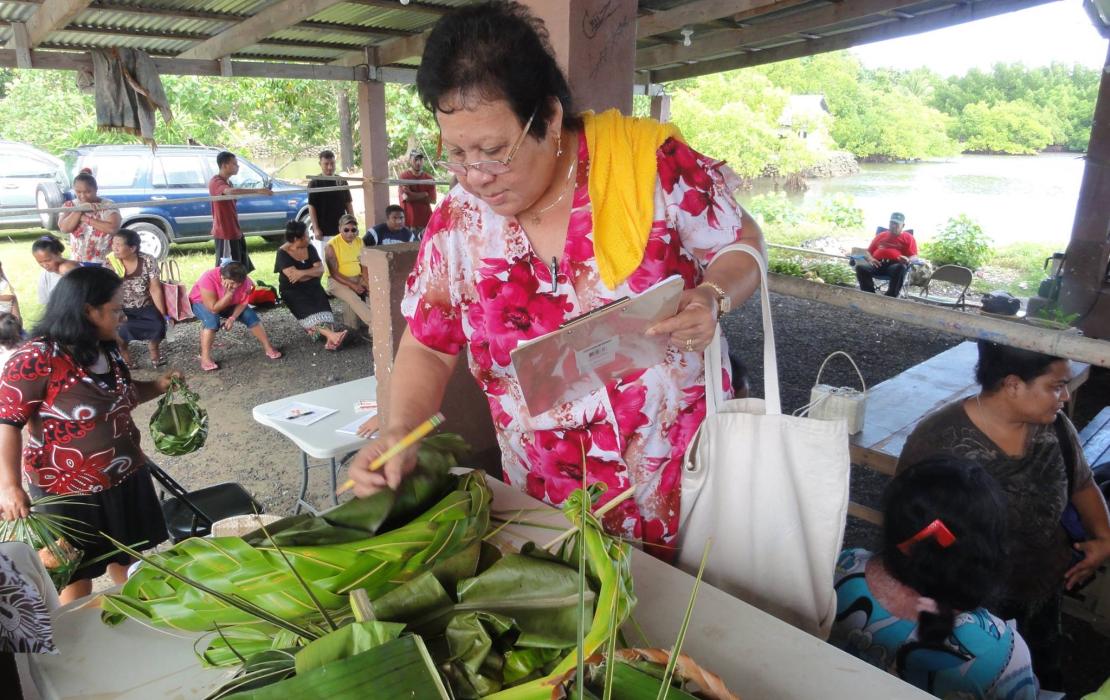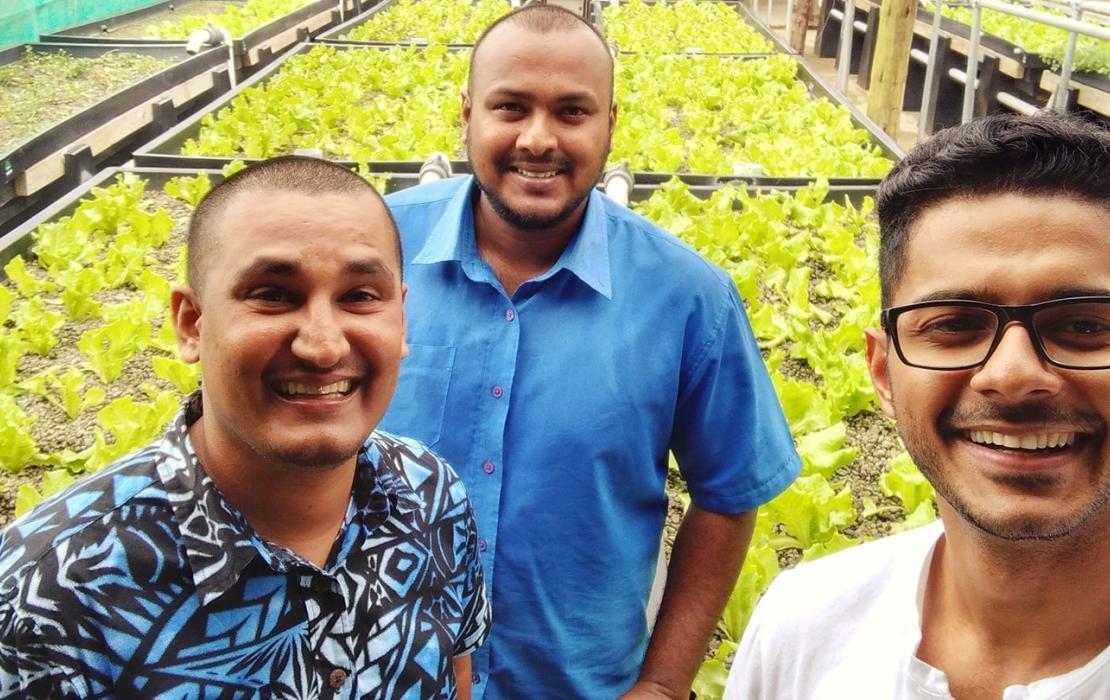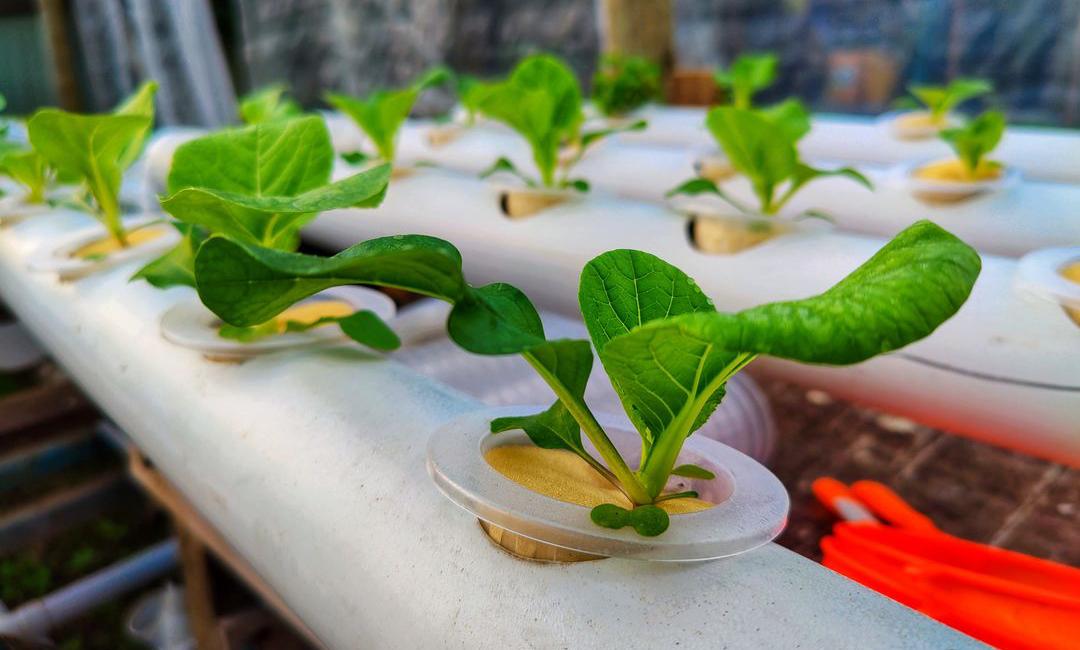
Photo: Island Food Community of Pohnpei

Photo: Island Food Community of Pohnpei
In households across the Pacific, shifting rainfall patterns, more extreme weather events, and saltwater intrusion are disrupting livelihoods and food production. As a result, households face growing uncertainty about their future.
Capitalizing on local resources and knowledge, local actors are stepping up to develop innovative adaptation solutions, empowering communities to tackle the challenges head-on.
In Micronesia, non-profit organization Island Food Community of Pohnpei (IFCP) is transforming local food systems by processing indigenous crops into versatile flours, offering a sustainable alternative to imported wheat flour.
In Fiji, an initiative set up by young entrepreneur Rinesh Sharma, Smart Farms Fiji, is supplying small-scale farmers with home hydroponic kits, allowing them to cultivate fresh fruits and vegetables year-round in a controlled environment.
The two organizations are among 44 local organizations worldwide supported by grants from the UNDP-Adaptation Fund Climate Innovation Accelerator.
These are their stories.
Reducing reliance on imported food and combating climate change in Micronesia – Island Food Community of Pohnpei

Photo: Island Food Community of Pohnpei

Photo: Island Food Community of Pohnpei
In Pohnpei, local food champion Emihner Johnson is planning a recipe contest to grab the attention of restaurants, shops and the public. She wants to showcase new flour products milled from indigenous crops like banana, taro, bread fruit and tapioca, by women who live an hour or two away by boat, in Chuuk.
Pohnpei and Chuuk are two of the four federated states of Micronesia, a country comprising over 600 islands across the western Pacific Ocean. Nearly all the country’s food is imported with a heavy carbon footprint, including wheat flour.
That’s one of the reasons why, for several years now, Johnson and the Island Food Community of Pohnpei (IFCP) have been saying “let’s go local” instead. She says there are many climate, health and economic benefits to processing traditional home-grown crops into versatile flours that have a long shelf-life.
Johnson says that traditionally, people would harvest, boil and eat indigenous crops immediately to avoid spoiling. A lot ended up going to waste.
“We fry them, we chop them, we bake them in different dishes. But it has to be eaten in one or two days,” says Johnson. By sun-drying and milling what’s left over, the crops gain a longer shelf-life. It is also an opportunity for people to package, transport and sell it as a product for extra income to ensure food security.
Scientific analyses commissioned by the IFCP also demonstrated the flours are far more nutritious than the wheat flour most people buy today.

Photo: Island Food Community of Pohnpei
Food security in Micronesia, like almost everywhere else, is also being negatively impacted by climate change. In the case of taro crops, for instance, rising sea levels and higher tides cause more saltwater intrusion into the swamps where they grow.
“Once it goes in the taro, you cannot eat the taro the traditional way; the only way we’ve been eating it. It’s so spongy. It’s so sour, like you’re eating something that is not food.”
But by milling the spongy taro, it is possible to turn it into edible flour, says Johnson. “We’re turning that damage into good.”
The flour is milled using a machine that IFCP procured for Women’s Council of Chuuk using a small grant from the UNDP-Adaptation Fund Climate Innovation Accelerator (AFCIA), a programme aimed at supporting locally led climate innovation in developing countries. Johnson says the machine drastically reduces the time and labour involved in the process.
The women who were shown how the machine works, who come from disadvantaged backgrounds, were impressed at just how much time they could save: a task that would usually take them four hours by hand takes just five minutes using the machine. "Some women cried when they saw it," says Johnson, acknowledging that women generally have a lot of responsibilities, so time is a precious currency.
Johnson says they are still working on training the women in packaging, but they want to raise awareness about the flour products among potential buyers, particularly in Pohnpei.

Photo: Island Food Community of Pohnpei

Photo: Island Food Community of Pohnpei
“The capital [Palikir] has the restaurants and markets, so these are the business communities I want to attract … so that the women can earn some money if they have surplus,” she says. “And also those that don’t farm can have access to local healthy foods.”
She says this project, from the entire island communities’ perspective, is something very sustainable. It is for anyone who grew up on these islands, she says, whether or not they have money. “The environment is right there. Just give them the right tools to help them to go somewhere.”
At an upcoming recipe contest in Pohnpei, the winners will receive prizes and the public will be able to taste test the recipes. Johnson hopes that at least one dish will make it onto the menu of a restaurant. “It might be a baby step, but it’s a big deal for us.”
In Fiji, Smart Farms Fiji supports small-scale farmers to supplement produce using home hydroponic kits

Photo: Smart Farms Fiji

Photo: Smart Farms Fiji
In Fiji, Rinesh Sharma’s team has just delivered several hydroponic kits to mostly young women.
A single kit can sustain one to two people using locally available materials such as coconut husk and river rocks. “We have a lot of coconut trees in Fiji, so that’s used as a growing medium,” says Sharma. He adds that repurposing husks also encourages people not to burn coconut waste, and in doing so prevents further pollution.
Sharma founded his non-profit organization, Smart Farms Fiji in 2018. His idea was to support subsistence farmers to produce fruit and vegetables year-round using precision agriculture, in the form of a controlled hydroponic system.
Supported with a small grant from the UNDP-AFCIA programme, he set out to bring the technology to 150 community members in Koroipita, a settlement in Fiji’s second largest city, Lautoka. More than three-quarters of the 150 recipients of the smart farming kits were young people and women.
Sharma says the project encourages healthy eating and food security at the household level and raises awareness about agricultural resilience in the face of climate change.

Photo: Smart Farms Fiji
His organization provides the kits to people who already farm on soil. The idea is to supplement what those individuals are already producing and consuming, and to build on their existing agricultural knowledge.
Each recipient receives training on the science behind the hydroponic growing process. Sharma says they explain in a simple way how to avoid crop failure since hydroponic systems globally have a rather high failure rate.
“We provide them with a briefing of how to get on with this and how to have a successful system,” he says.
Despite the steep learning curve, there are many benefits to hydroponic systems. “Hydroponic cultivation techniques require less water than traditional agriculture practices, allow for greater plant diversification, and are portable, thus allowing for plants to be relocated during extreme weather events,” he explains.
He says Fiji has been experiencing unprecedented adverse weather conditions. “We had some massive rain pouring down and a few people I know got their kits into the safety sheds or storage.”

Photo: Smart Farms Fiji

Photo: Smart Farms Fiji
The home kits are small and easy to transport, he says, but even those farming with hydroponics on a larger scale are able to safely stow away their components. “Once the weather is fine, they fix it all back together.”
Another advantage of the Smart Gro Box is that it is built from scratch in the Fiji Islands. Sharma says they use local raw materials and labour where possible to respect and preserve Fijian culture and authenticity.
However, with fuel price hikes (since Fiji is heavily reliant on imports), prices have soared since the start of the project. “It was a challenge to negotiate the prices we initially had asked for with the suppliers,” Sharma says.
He adds that the market in Fiji is not what it may look like from the outside. “Everyone loves your initiative and will give you a thumbs up, but when trying to stay relevant and trying to enter any market, you have [extreme] competition.”
Sharma says that if more funding became available, he would be able to pinpoint particularly deserving farmers who would stand a good chance of success and would advocate for “backup support” from the country’s ministries.
He says they are working to connect some of the young and ambitious entrepreneurs who are beneficiaries of the project to other initiatives, and that his foundation will soon support one hundred women vendors who are already selling their produce at the market.
“A lot of them are in horticulture and in the sales of flowers and bouquets,” he says. If his team is successful in obtaining further funding, they will support these entrepreneurs to navigate high stall fees.
Sharma says that overall, this support and the hydroponic kits represents a coming together of modern technology and traditional practices to sustain farming and livelihoods on the island.
About the AFCIA programme
These stories have been co-created with support from the Climate and Development Knowledge Network (CDKN) and UNDP in the framework of the UNDP-managed Adaptation Fund Climate Innovation Accelerator programme (UNDP-AFCIA).
Supported by financial contributions from the Adaptation Fund and the European Union, the UNDP-AFCIA programme has awarded 44 micro and small grants to locally led organizations across 33 countries worldwide, accelerating their innovative solutions to build resilience in the most vulnerable communities.
UNDP-AFCIA is one of two featured programmes under the Adaptation Innovation Marketplace (AIM), a multi-stakeholder strategic platform that promotes scaled-up adaptation at the local level.